Jacob & Co’s Jean Bugatti Tourbillon Chronograph
Jacob & Co’s new Jean Bugatti model features an elegant dial with extensive rose gold appliques, and the overall appearance of a 1930’s Bugatti roadster grille. Share
Jacob & Co. Jean Bugatti is a groundbreaking mechanical accomplishment, available with a rose gold case and cream-white dial, or a white gold case with blue dial, both of which are limited to 57 pieces.
With this new timepiece, Jacob & Co. takes on a new challenge. In terms of design, of complication, of historical grounding, the Jean Bugatti is one of the most sophisticated timepieces to be released in recent years. Among those, it just might be the most complex chronograph. And in a design territory that Jacob & Co. hadn’t delved into yet.
The Jean Bugatti presents itself in the guise of a classical, elegant, refined timepiece with a pronounced retro feel. This is the latest offspring of the fruitful partnership between Jacob & Co. and Bugatti Automobiles.
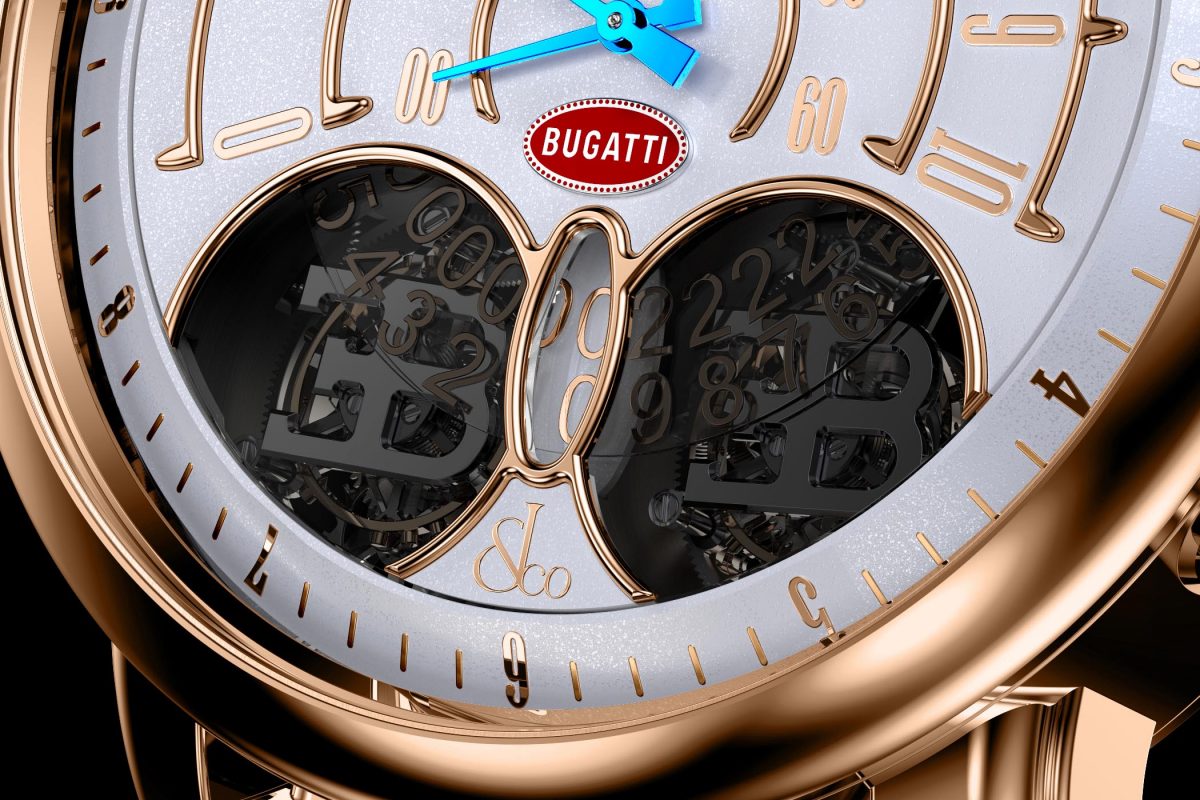
It has a round case, a round bezel, short and elaborate lugs, a traditional architecture. Mushroom pushers, full-polished rose or white gold case, elegant cursive applied numerals, blued hands, blue or cream-white dial, the 46-mm Jean Bugatti would almost look tame if it weren’t for its unique layout. The Jean Bugatti feels like the dashboard of a collectible Bugatti car. And the openings at the bottom of the dial feel like the grille and headlights of a 1930’s coupé from Molsheim.
The Jean Bugatti is grounded in the rich history of the Bugatti automotive brand. Jean was the eldest son of founder Ettore Bugatti. Born in 1909, the same year when Ettore set up his new company in Molsheim, Alsace, in north-eastern France. As a child, Jean loved to watch his father and the draftsmen designing and developing. He often secretly ran through the production facilities watching the drawings come to life.
Young, curious and experimental as he was, the post-war French “Années Folles” (crazy years) had a huge influence on him. He would visit his grandfather Carlo -who was a member of the Académie des Beaux Arts in Paris since 1875 –as often as he could in the French capital. Carlo Bugatti loved mixing materials, cultures and styles in his furniture and decorative artefacts, inspiring Jean to do the same in his automotive designs.
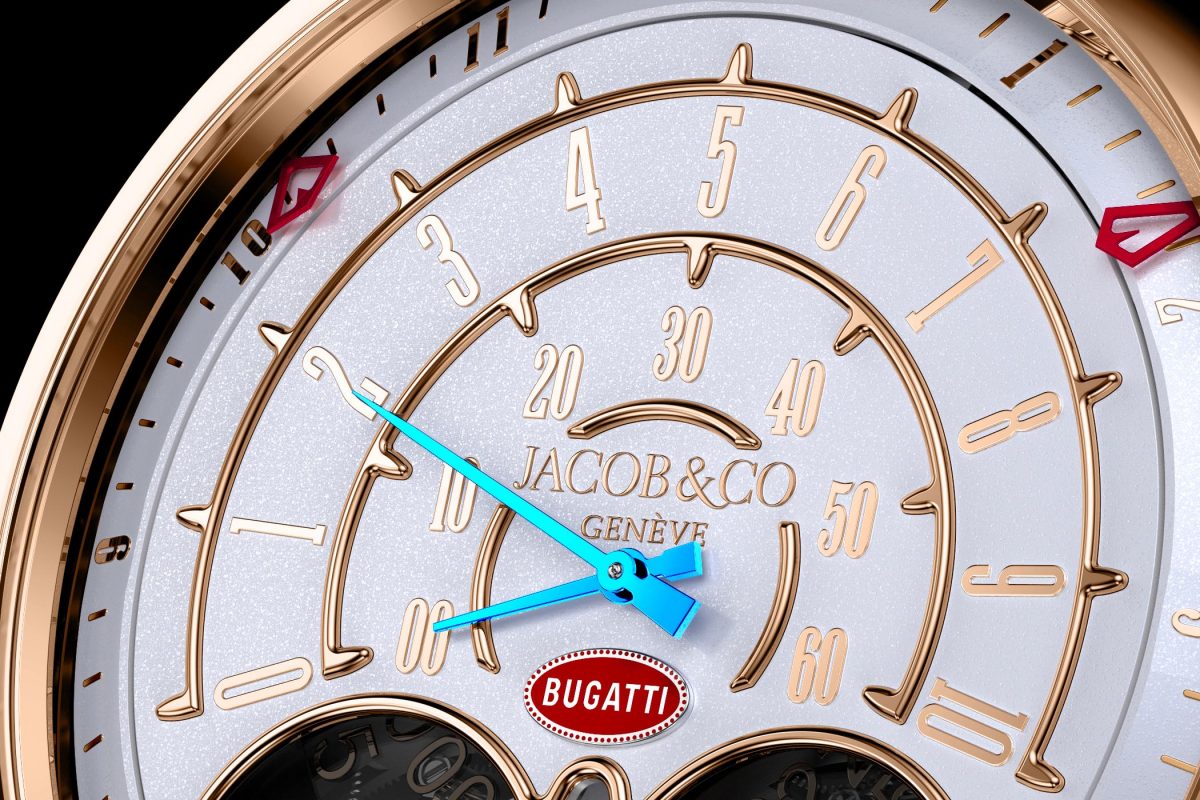
This led to such masterpieces as the duotone Type 50 series, the Type 41 Royale with the longest wheelbase ever and the Type 57SC Atlantic, the most expensive collector’s car in the world. The Atlantic had an extremely long bonnet and an oval-shaped rear end extending almost to the ground, from which six thin tailpipes protrude. The outstanding design feature was the Atlantic’s raised seam which ran vertically from the hinge in the split bonnet to the tail. Proportions unknown in the automotive world at the time. The Jean Bugatti is atribute to this extraordinary innovator and his avant-garde and artistic automotive interpretations.
Just as Jean Bugatti’s sense of automotive design was definitely outside the box, so is the appearance of the eponymous timepiece. It may look classical, but as was to be expected from Jacob & Co., it really isn’t.
What are these two large openings at 5 and 7 o’clock under discs of smoked sapphire? Why are the hands pointing in a direction that makes no apparent sense? And is that a verticallarge date at 6 o’clock? At first glance, the Jean Bugatti is puzzling. As it turns out, there is good reason to be surprised, and subsequently impressed. The two openings on the dial harbor a pair of one-minute tourbillons. Their cage design is topped bythe Bugatti EB logo, manufactured in perfectly polished steel. And since they’re held only by their underpinnings, they’re both flying tourbillons.
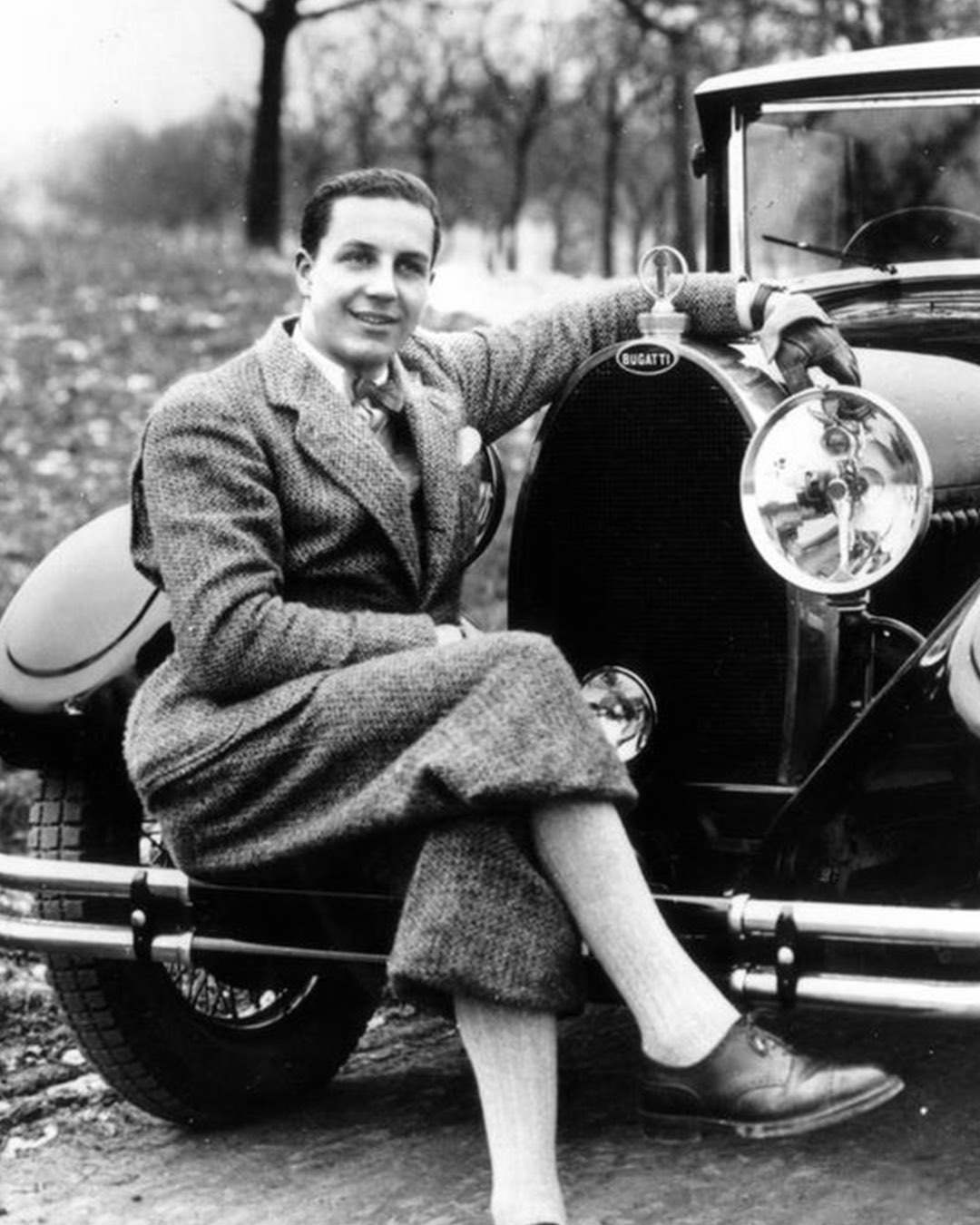
The pair of short, blued hands anchored in the middle of the dial are really the chronograph hands. The first, longer one stands for the chronograph’s second’s units. The other, shorter and laid out just underneath, is in charge of the chronograph’s second’s tens.
When the start/stop pusher is activated, the first hand starts moving from 0 to 10. As it reaches 10, it jumps backwards to 0 and starts its course anew while the other hand has jumped forward, from 00 to 01. As time advances, the first retrograde hand keeps moving up like the rpms on a dashboard counter and back as the gears change. The other one soon reaches 60, at which point it also jumps backwards to 00.
At that point, in the oval medallion at 6 o’clock, a disc with gilded numerals has instantly jumped from 00 to 01. This 30-minute counter is made of sapphire in order not to dim the view on the pair of tourbillons. This separate second with double retrograde hands and a digital jumping minute disc is a completely unique feature.
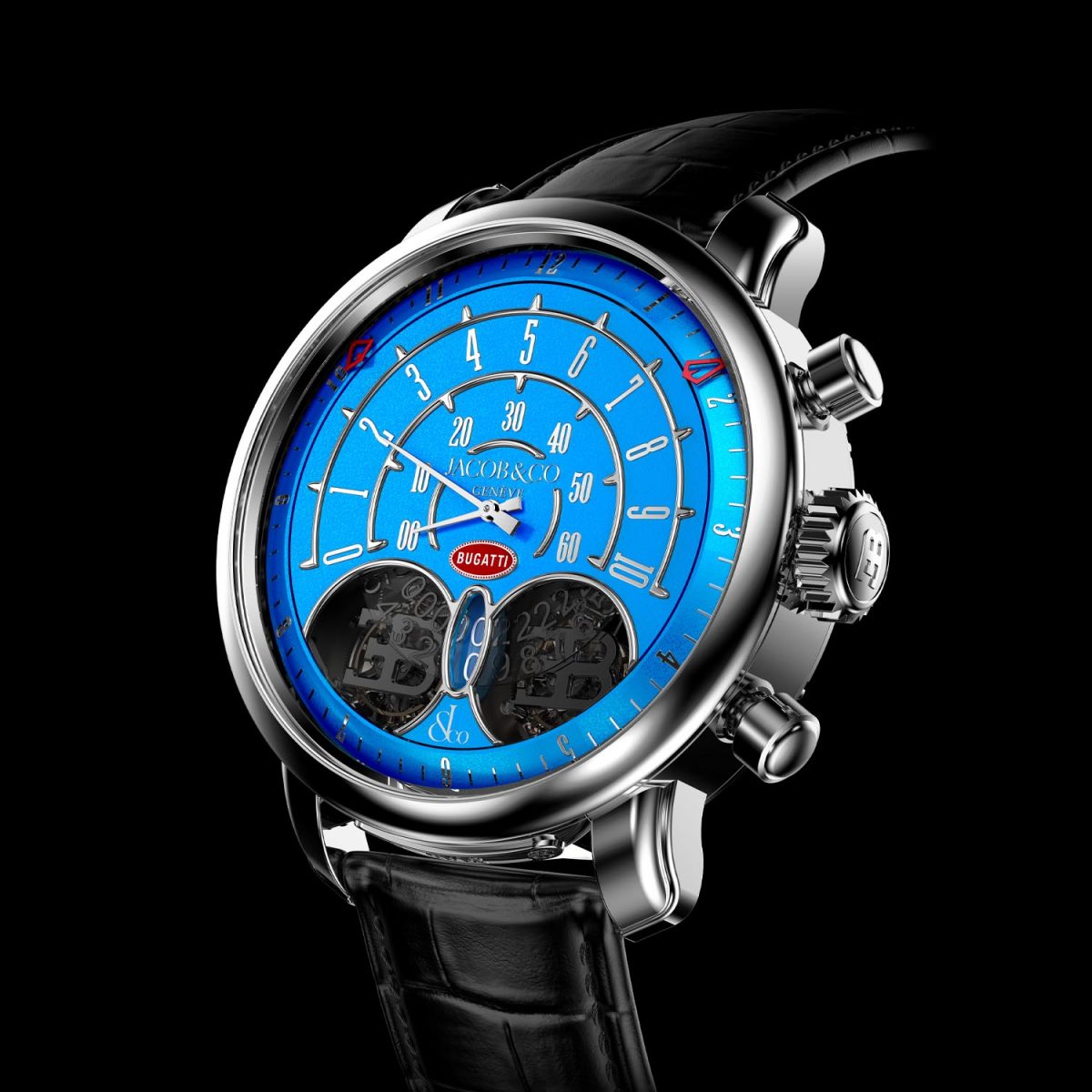
Furthermore, when the chronograph is stopped and reset, the seconds’ hands cannot jump backwards regardless of the position they’ve stopped at. If they haven’t reached the end of their course, the spring that propels them backwards hasn’t gathered sufficient energy. In order to execute the reset, they slowly continue their course to their final position, and only then can they make their final retrograde leap.
To manage this very complex and unique chronograph system, calibre JCFM09 is fitted with a double set of regulating organs. A small balance wheel is located at the back of the movement. It’s dedicated to the chronograph operation, as is a separate barrel. Together, they allow a two-hour power reserve of high accuracy measurement. Coordinated by a column wheel of extremely fine construction, this chronograph has been designed to offer the smoothest running possible and the best haptic return. The strength required to engage the pushers is minimal.
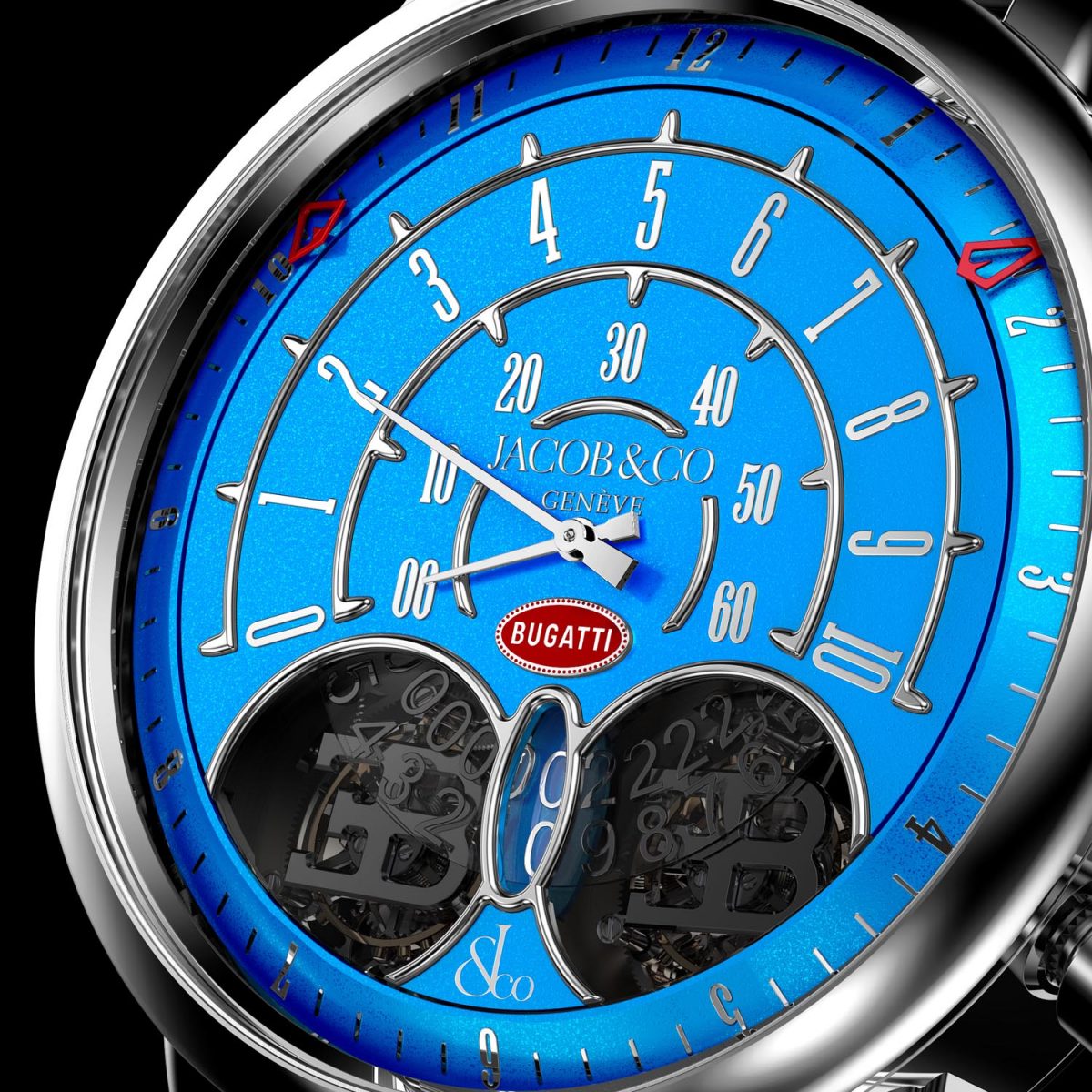
But then, what of time indication? As the dial’s center is occupied by the chronograph hands,where are the hours and minutes? Pointing inwards, located on the outside rim of the dial, two short, red hands provide that essential indication. They run on the same scale, meaning they must cross paths as the minute pointer catches up with the hour pointer. A difference in elevation allows this smooth passage 24 times a day.
These red hands are directly linked to the movement’s time-operating parts, regulated by a pair of one-minute tourbillons, running at 21’600 vphand operating side by side. Their timing information may differ slightly, as is the purpose of twin tourbillons. A spring-clutch located between them averages out their running and provides the movement with unified, chronometrically enhanced timekeeping.This system is linked to a unique barrel. It endows the Jean Bugatti with a 48-hour power reserve.

The Jean Bugatti may just be Jacob & Co.’s most demanding watchmaking project ever. Even for the creator of uber-complications such as the Astronomia, Twin Turbo Fast & Furious or Bugatti Chiron, the development and manufacturing of calibre JCFM09 presented a series of intense challenges.
Overall, the graphic impression left by calibre JCFM09 is impressive. The openworked components are highly-polished and beveled. They stand out against the backdrop of a circular-grained, all blacked-out mainplate. A forest of springs, levers, clutches and impressive mirror-polished bridges create a dense technical environment that draws the eye and arouses the viewer’s curiosity. In that respect, as in many others, the Jean Bugatti is a timepiece to behold.
Guide Price: USD 250,000
Technical Specifications
Movement
- Caliber: Hand-Winding, Jacob&Co JCFM09, Column Wheel, Bi-Retrograde and Digital Chronograph; Twin Flying One-Minute Tourbillons at 5 and 7 o’clock.
- Diameter: 41.55 mm
- Height: 8.92 mm
- Components: 470
- Functions: Peripheral Hours and Minutes; Chronograph with Retrograde, Separate Tens and Units of Seconds’ Hands; Digital, Jumping 30-Minute Counter at 6 o’clock.
- Power Reserve: 48 Hours
- Frequency: 21’600 vph (3 Hz)
- Chronograph Power Reserve: 2 Hours
- Frequency: 36’000 vph (5 Hz)
- Jewels: 92
- Finishings: Black Chromium, Circular-grained Mainplate; Polished and Beveled Bridges; Openworked, Beveled and Horizontal-grained Levers and Clutches; Gold-Plated, Openworked Balance-wheel Bridge; Sand-blasted Barrels. Mirror-polished, Beveled, EB-shaped Tourbillon Cages.
Case
- Diameter: 46 mm
- Height: 16 mm
- Material: 18K Rose Gold or White Gold
- Case Back: Sapphire GlassCrystal: Domed Sapphire with Anti-Reflective TreatmentNumber Plate : 18K Gold Applique with Unit Number / 18Water resistance: 30 m (100 ft)Dial & Hands:Dial: Cream-white or Blue; Rose Gold-plated Chronograph Counter Appliques and Arabic Numerals on Minute Track; Smoked Sapphire Tourbillon Covers.
- Hands: Red, Inward-pointing, Openworked Hour and Minute Hands; Blued Chronograph Hands; Sapphire 30-minute Counter Disc
Strap & Clasp
- Strap: Blue Alligator with Blue Stitching or Black Alligator with Black Stitching
- Clasp: 18K Rose or White Gold Deployment Clasp
Limited Edition
- 57 pieces in 18K Rose Gold
- 57 pieces in 18K White Gold



